Incorporation Of Traditional Knowledge Into Geoscience Education: An Effective Method Of Native American Instruction
Smythe JSE May 2017 14 Regenerative Agriculture PDF
Introduction
Statistically, Native Americans/Alaska Natives (NA/AN) are the most underrepresented group in STEM despite the fact that NA/AN groups integrate an understanding of the natural world as an important part of their cultural heritage (Baker, 2007; Barnhart, 2005). The Commission on Professionals in Science and Technology found that only 0.3% NA/AN were employed in traditional science and engineering (STEM) occupations (Babco, 2000). As such, the specific objectives of this GEP are to encourage Alaska Native participation in STEM education while fostering a community-wide appreciation of the value of the STEM disciplines when coupled with TEK.
Unlike mainstream Western knowledge systems, TEK encompasses an understanding of geological, biological, environmental, and spiritual elements as one holistic system that accounts for the health of an entire ecosystem by interconnecting ecological communities (Barnhardt & Kawagley, 2005; Semken, 2005). We have developed a place-based, culturally competent (Bueno Watts and Smythe, 2014) GEP that couples TEK and Native language – specifically, Haida – with Western Science. We based the GEP on a bottom-up approach (Hugo et al., 2013) by teaching STEM as a community-inclusive program incorporating guidance from tribal elders and leaders, community members, parents, teachers, and students. The result is a community-centered program built on the traditions by which Alaska Native students understand and interact with the natural world (Fig. 1). Our approach was designed to respect and reinforce Alaska Native TEK while providing a scientific basis for that knowledge, following current thinking in place-based education, which requires us to view humans as one part of the natural world and human cultures as an outgrowth of interactions between species and particular places (Kawagley & Barnhardt, 1999b; Smith and Williams, 1999). This is in contrast to direct instruction practices which discourage the natural inquiry process (EBC, 2004), by dismissing observations and perspectives of the natural world by indigenous peoples (Deyhle, 2010; Kawagley & Barnhardt, 1999a; Haig-Brown, 1995), and which are often ineffective for teaching Native students (Cajete, 1999; Deyhle & Swisher, 1997).

Figure 1. Schematic depicting differences in bottom-up and top-down approaches. Bottom-up results in increased recruitment and retention rates when students have a solid support system that includes family, community, elders, and tribal members. The top-down approach engages individual students without considering the support group, resulting in decreased retention rates.
The GEP took the constructionist view (eg. people learn by constructions their own knowledge) that inquiry-based education would lead to a greater understanding of STEM disciplines (Handelsman, Miller, and Pfund, 2007; Bransford et al., 2000). The Earth Systems approach of modern geoscience disciplines is well suited to complement and support TEK and cultural belief systems in conjunction with STEM disciplines (Riggs, 2005). Our systems-based approach considers TEK and STEM as equally valid perspectives of student observations (Hugo et al., 2013).
Cultural Awareness
Indigenous populations have survived on cultural and traditional use of locally derived food and material resources for thousands of years, through the observation and understanding of environmental ecosystems and processes. For generations elders have curated this TEK and have passed it down through oral traditions that interweave metaphorical lessons and cultural wisdom with empirical observations (Barnhardt & Kawagley, 2005; Simpson, 2002; Nelson-Barber & Estrin, 1995). This communal knowledge of local systems can be used to engage Native youth in STEM inquiries in a way that is culturally aware and respectful, and easily related to the students’ prior understanding.
Students who participated in the GEP acquired skills that readied them both for effective community management of coastal tribal resources and natural resource STEM careers. It is important to encourage Native scientists not only because of their vested interest in the preservation of native lands and resources, but also because of their relationship to the historic knowledge of the region. From an early age, knowledge of the environment, natural resources and history of the region have been instilled in Native youth, fostering an inherent understanding of how specific ecosystems function and what role the community plays in shaping these ecosystems. TEK is incorporated as an integral role of the Native scientist to encourage native youth to pursue careers in STEM disciplines, Additionally, TEK is retained within the community as holistically educated youth become tribal leaders, resource managers, environmental planners, and schoolteachers, leading to application of TEK in community planning and communication with policy makers.
A key component in this program was the incorporation and utilization of our traditional Haida language. We worked closely with tribal elders to develop this project and curriculum to incorporate both our Traditional Knowledge and language (Appendix I). Providing an English glossary of terms and definitions to the elders allowed them the opportunity to either translate glossary terms into Haida or develop a new Haida term (i.e. there was no Haida word for computer). We also interviewed elder Claude (Miijuu) Morrison (100 years old) about the Haida being an endangered language, with only six fluent speakers in the community;
Q1: “When you grew up when only Haida language was spoken, spoken in the homes, with friends, uncles & aunts”
A1: “Just Haida language was spoken. Yeah”
Q2: “And now there’s hardly any
A2: “Hardly anyone who understands our language, and they have to have teachers come in and teach it now.”
Q3: “Could you speak it (Haida) in school?”
A3: “No we were told not to speak it, above the door there’s signs “Speak English”
Geoscience Education in a Haida Community
Southeast Alaska is the main territory of the American Haida population. The community the GEP was implemented in was Hydaburg, located in a temperate coastal rain forest on Prince of Wales Island. This region is rich with natural resources and the Haida community has retained much of their knowledge and skills pertaining to customary and traditional use of local resources. The community is centered on the Hydaburg River, which runs into the Pacific Ocean, presenting a multitude of freshwater and marine habitats. The Haida settled on Prince of Wales Island in the 16th century, having emigrated from Haida Gwaii, located on the coast of British Columbia (Hugo et al., 2013).
Our goal was to offer a culturally relevant, geoscience education program. In doing so the GEP did deviate from the best practices identified by Mack (2012) in that we did not use an explicit “culture first” method. This was for two reasons: (a) only two tribal members, the town’s environmental planner and the GEP team leader, had Western science expertise, with most of the program being led by non-natives who were not culturally fluent; and (b) because students do not speak fluent Haida, instruction was primarily in English, throughout the GEP we worked with a Haida linguist to begin to incorporate Haida terms.
Importance of Community Involvement
NA/AN community members are bound together by intimate social and cultural connections forming close-knit groups. Education systems often fail to recognize that community support is important to NA/AN students for encouragement and to maintain their cultural identity, both of which are vital to the student success. Native students that receive community support are more likely to seek post-secondary education due to solid support and cultural foundation, the incorporation of tradition, language, and spirituality, and by maintaining interpersonal relationships with tribal members and within tribal communities (Bueno Watts and Smythe, 2014).
Our model for community support uses a bottom-up, pyramidal, approach, in which elders and tribal leadership form the base, providing a strong foundation critical for student success (Hugo et al., 2013). Ascending the pyramid the model progressively narrows, focusing in on community members, parents, family, school administration, with students at the top of the pyramid (Fig. 1). Education programs and institutions using this bottom-up approach will effectively educate, retain and empower Native students for success. Co-operative collaborations within tribal communities is essential for the success of Native students; a positive feedback cycle of support and encouragement can be established by working directly with community members who support students.
Research focused on NA/AN communities has demonstrated that this bottom up approach is a highly effective strategy for teaching STEM disciplines, particularly when science activities are tailored to the needs and interests of the community itself (Bueno Watts and Smythe, 2013; Hugo et al., 2013; Boyer, 2006; Henderson & Royster, 2003). Studies indicate that when indigenous youth were engaged in Geoscience programs using an outdoor inquiry-based pedagogy they achieved higher scores on standardized science tests (Zwick and Miller, 1996). In addition to improved test performance, these strategies enhance self-esteem (Cleary and Peacock, 1998), healthy identity formation (Trujillo, Viri and Figueira, 2002), self-directedness (Garcia and Ahler, 1992), and most importantly, respect toward tribal elders (Agbo, 2004). Collectively these characteristics result in youth who provide a positive influence within their tribal communities.
For all of these reasons, our GEP coordinated several place-based, authentic STEM projects in which students had the opportunity to collect and interpret real data about environmental issues of concern to their community at large. Projects included chemical and microbiological surveys of drinking water, environmental assessments of local watersheds and coastal ecosystems, and habitat assessment. For the project described in this manuscript, discussions with the community, tribal and governmental leaders exposed community concerns about the health of the coastal ecosystem. This was addressed by investigating the presence and level of activity of shipworms in the marina with students from the Hydaburg School.
Coastal Habitat Assessment Using Shipworms
Shipworms (Family Teredinidae) are not actually worms, as the name would imply. Rather, shipworms are marine bi-valve mollusks related to soft-shell clams (Family Myidae) that bore into woody substrates for shelter and nutrients using a small-ridged shell that is adapted for the purpose of burrowing into wood. These organisms are capable of utilizing wood cellulose as their primary food source, and are widely distributed in tropical and temperate coastal environments. Like most Mollusca, shipworms are soft-bodied animals with a calcium carbonate shell. However, in contrast to other mollusks, shipworms have evolved an elongated body with a shell that is significantly reduced in size (Fig. 3). The most common shipworm species found along the west coast, from California to Alaska, of the U.S. is Bankia setacea.
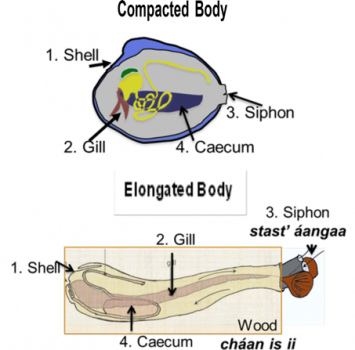
Figure 2. Schematic comparing body plan and shell size of soft-shell clam with that of the shipworm Bankia setacea. Note the elongated body and reduced shell size of the shipworm.
Project Development
The project was developed by first interviewing tribal elders to record the TEK of shipworm history and ecology. Secondly, we met with tribal leaders who provided valuable information pertaining to the history and water quality of the coastal ecosystem to couple with TEK. Finally, we collaborated with scientists specializing in shipworm research in an effort to build a bridge between TEK and Western STEM disciplines and the tribal community with academia. Once a holistic review was completed, key vocabulary terms were identified to develop a glossary that was given to elders to translate into the Haida language (Bueno Watts and Smythe, 2013). This facilitated the incorporation of the Haida language into geoscience education and the expansion of the Haida language, as many of the glossary terms had no formal translation. For these terms, elders used the definition of the term to formulate a new word. A fluent Haida linguist, connecting western science, TEK, and Native language, and helping to rekindle interest in the Haida language for many students, taught English and Haida science terms to students, teachers, and scientists.
Project Description
The shipworm project was designed to help students develop critical science inquiry skills while applying a variety of math and science disciplines. Initially low-tech, hands-on activities such as shipworm trap construction and visual monitoring were used to determine the location of shipworms in the local marina. The field component allowed students to design and deploy traps in addition to monitoring physical parameters, such as including GPS coordinates, temperature, and salinity of surface water.
Traps consisted of five 30.48 x 30.48 x 2.54 cm blocks of wood, placed 3 m apart on a nylon rope and suspended vertically in the water column to allow for a depth profile of colonization (Fig. 3A-C). Wood substrates were chosen from locally available tree species and students were given the option to choose a hard wood (alder, Fig. 3D) or soft wood (red cedar Fig. 3E) to construct traps. Traps were periodically monitored for signs of shipworm colonization. Once colonization was confirmed, traps were harvested and transferred to the classroom (Fig. 3F-G). Traps were photographed and cleaned to remove barnacles, sponges, and seaweed for further observation and characterization.

Figure 3. A. Students constructing traps for deployment at the local marina. B. Deployment of the traps, allowing for vertical colonization profiles of the water column. C. Traps covered with barnacles, sponges, and seaweed. D. Hard wood (alder) colonization by shipworms. Note that the wood is still intact with little depredation. E. Softwood (red cedar) colonization. Note the shipworm pallet protruding from the highly degraded wood. F. Removal of shipworms from softwood substrate. G. Examination of the shipworm burrows in woody substrate.
These initial environmental studies were then enhanced by utilization of high-tech instrumentation such as scanning electron microscopy (SEM) and computed tomography (CT) to visualize in-situ shipworm colonization of the hard wood alder substrates. SEM analyses allowed students to compare and contrast structural differences between clam and shipworm shells at high magnification, while CT allowed students to observe in-situ the number, location and morphology of live shipworms in their woody substrates (Fig 6).
Shipworm shells, 0.25 cm, were significantly reduced in size as compared to a clamshell, 10.16 cm (Fig. 4 and 5 left). Upon increased magnification of shell surfaces there are obvious modifications indicative of the different niches these two organisms occupy. The shipworm shell surface is ridged and toothed to allow it to burrow into woody substrates by rotating the shell side to side, in contrast the clamshell surface has large ridges that allow the animal to burrow into muds and possess pores to allow for fluid and gas exchange (Fig. 4 and 5 left).
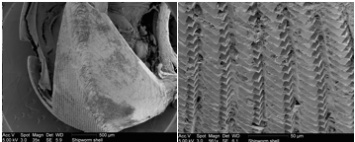
Figure 4. (Left) SEM micrograph of shipworm shell, magnification 36x. (Right) Micrograph of shell surface, magnification 561x, notice the toothed surface texture, the shell is used primarily for burrowing into wood.
- Figure 5. (Left) SEM micrograph of a portion of a clamshell, magnification 36x. (Right) Micrograph of clamshell, magnification 2500x, notice the smooth large ridges and pore space.
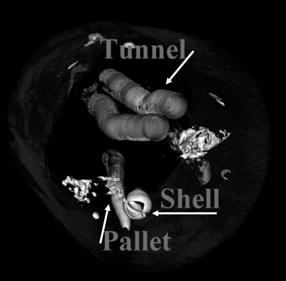
Figure 6. Computer tomography image of hard wood (alder) showing the shipworm inside the wood. Note the shell (arrows), burrow, and pallets.
Project Design
The research project incorporated classroom lectures and hands-on field activities, allowing students to actively participate in all aspects of experimental design, implementation, and data collection. The classroom component focused on concepts such as the scientific method for experimental design, environmental health, and monitoring techniques. Here the concepts of dependent and independent variables were introduced, with students choosing the independent variables (i.e. depth in water column and wood type) and quantifying the dependent variables (shipworm presence/absence, abundance, and the degree of wood degradation). Students worked in groups to construct shipworm traps and were responsible for selecting independent variables such as substrate, depth and location of traps.
Retrieved traps were distributed to grades 6 – 12 science classes and used for lessons that covered a variety of topics. For example, anatomy and physiology students dissected shipworms and clams while comparing and contrasting the body plan and shell of each animal, as well as studying the relevant chemistry, oceanography, environmental science and math.
Project Results and Community Benefits
Students found that colonization typically occurred in the red cedar softwood traps more quickly than hardwood alder traps. In addition, we found that traps located above 10 m showed no signs of shipworm colonization, while traps below 10 m depth were colonized on average with 12 animals per trap. These results suggested an environmental factor that inhibited shipworm colonization above 10 m. After further analyses, data and results were presented to the tribe. The tribe developed a proactive approach, working with students to develop a marine remediation plan, which consisted of the removal of 4 tons of derelict marine debris and continued monitoring of the marina using shipworm bioassessment.
Learning Outcomes
Bioassessment of the local marina using shipworms provided students an example of the dynamic nature of a species colonizing a new habitat (deployed shipworm traps) and the interplay between competing species (sponges and barnacles) colonizing trap surfaces. The shipworm project taught them how to choose indicator species for different environments – e.g. shipworms for marine systems and macroinvertebrates for lotic systems. The study of shipworm growth under variable environmental conditions is ongoing; MacIntosh et al. (2012) demonstrated that recruitment to wood substrates is highly dependent on the viability of the broadcasted shipworm larvae. Student observations of shipworm abundance and distribution were valuable to determine the environmental health of coast marine ecosystems.
Discussion
This Native community was aware of shipworm colonization of wood, as they are known to accelerate degradation of wood structures such as docks and boats. However, the use of these animals as indicators of environmental health was not a previously used practice. Scientific skills gained from involvement in this Geoscience Education Research Project led to tribal summer internships for students to continue to monitor marine ecosystems.
Additionally, the pathway has been established for discussions pertaining to the anthropogenic influences in marine ecosystems with respect to traditional stories and future impacts on not only tribal resources but also the environment across Alaska.
Prior to the implementation of this GEP approximately 5% of high school graduates enrolled in college or trade school. Since the implementation of this GEP we found that up to 75% of high school graduates sought post-secondary education. This GEP has begun to bridge the gap between the generations by incorporating TEK from the elders (personal communication, 2014) coupled with STEM disciplines (Bueno Watts and Smythe, 2014).
Our pedagogical approach addresses National Science Standards (NGSS Lead States, 2013) to ensure students are adequately prepared to reach their educational goals (Appendix I). We recognize the importance of meeting standards in order to allow lessons to be incorporated into a science curriculum. The most powerful piece of this geoscience research project, however, was the context in which it was developed. Lessons were rooted in the community, in which it was taught, utilizing and recognizing the importance of TEK through involvement of elders. This project was developed to demonstrate that TEK holds equal vales to Western Science.
Acknowledgements
We would like to thank Hydaburg Cooperative Association for their continued support and encouragement with this Geoscience Education Program. Many Thanks to our precious elders, Claude Morrison, Alma Cook, and Annie Peele, who guided us along this project and taught us the Haida language for this project. Special thanks to Doreen Witwer, Tony Christianson, and Melanie Kadake for support and guidance throughout this research project. Thanks to the many students who have continued this program and who diligently monitor traps year round; Nevaeh Peele, Lillian Borromeo, Treasean Miramontez, Chavonne Guthrie, and Taylor Natkong. Thanks to Dr. Margo Haygood (OHSU-IEH) and Dr. Dan Distel, Ocean Genome Legacy, for their guidance with this project and for editing this manuscript. Thanks to Carolyn Sheehan for her editing expertise, and to Antonio Baptista for his support and guidance. This work was supported by the National Science Foundation (NSF), through grant GEO-1034611.
References
Agbo, S.A. (2004). First Nations Perspective on Transforming the Status of Culture and Language in Schooling. JAIE, Vol. 45, No. 1, pp. 1-31.
Babco, E. (2000). The Status of Native Americans in Science and Engineering. Report for The Commission on Professions in Science and Technology.
Baker, M.A. (2007). Diversity in the Geosciences-We Can Do Better, Geotimes. http://www.agiweb.org/geotimes/jan07/scene.html.
Barnhart, R. (2005). Culture, Community, and Place in Alaska Native Education, Democracy and Education, 16(2).
Barnhardt, R., & Kawagley, A. O. (2005). Indigenous Knowledge Systems and Alaska Native Ways of Knowing. Anthropology & Education Quarterly, 36(1), 8–23. http://doi.org/10.1525/aeq.2005.36.1.008.
Boyer, P. (2006). It Takes a Native Community: Educators Reform Schools in an Era of Standards. Tribal College Journal of American Indian Higher Education, Vol. 17. No. 4, pp. 14-9.
Bransford, J. D., Brown, A. L., & Cocking, R. R. (2000). How People Learn: Brain, Mind, Experience, and School: Expanded Edition. National Academies Press. Retrieved from http://www.nap.edu/openbook.php.
Bueno Watts, N., and Smythe, W.F. (2014). The Geoscience Alliance: Building Capacity to Use Science for Sovereignty in Native Communities. Book: Future Earth: Advancing Civic Understanding of the Anthropocene, Edition: 1, Chapter: The Geoscience Alliance: Building Capacity to Use Science for Sovereignty in Native Communities, Publisher: American Geophysical Union, Editors: Diana Dalbotten, Gillian Rohrig, Patrick Hamilton, pp.67-76.
Bueno Watts, N., and Smythe, W.F. (2013). It Takes A Community To Raise A Scientist: A Case For Community-Inspired Research And Science Education In An Alaskan Native Community. Current: The Journal of Marine Education, Vol. 28, No. 3. pgs. 22-26.
Cajete, G. A. (1999). The Native American Learner and Bicultural Science Education (pp. 135–160).
Cleary, L. M., & Peacock, T. D. (1998). Collected Wisdom: American Indian
Education. Needham Heights, MA: Allyn & Bacon. (ERIC Document Reproduction Service No. ED 422 138).
Deyhle, D. (2010). Navajo Youth and Anglo Racism: Cultural Integrity and Resistance. Harvard Educational Review, 65(3), 403–445. Retrieved from http://her.hepg.org/content/156624q12053470n/.
Deyhle, D., & Swisher, K. (1997). Research in American Indian and Alaska Native Education: From Assimilation to Self-Determination. Review of Research in Education, 22, 113–194. http://doi.org/10.2307/1167375.
Garcia, R., and Ahler, J. (1992). Indian education: Assumptions, Ideologies, Strategies. In J. Reyher (Ed.), Teaching American Indian Students, pp. 13-32. Norman, OK, University of Oklahoma Press.
Haig-Brown, C. (1995). Two Worlds Together: Contradiction and Curriculum in First Nations Adult Science Education. Anthropology and Education Quarterly, 26(2), 193–212.
Handelsman, J., Miller, S., and Pfund, C. (2007). Scientific Teaching. The Wisconsin Program for Scientific Teaching. Roberts and Company. Twelfth Edition.
Hugo, R. C., Smythe, W. F., McAllister, S., Young, B., Maring, B., & Baptista, A. (2013). Lessons Learned from a Geoscience Education Program in an Alaska Native Community. The Journal of Sustainability Education, 5, available: jsedimensions.org/wordpress/content/lessons-learned-from-a-geoscience-education-program-in-an-alaska-native-community_2013_06.
Kawagley, A. O., & Barnhardt, R. (1999a). Alaska Native education: History and adaptation in the new millennium. Journal of American Indian Education, 39(1), 31–51. Retrieved from http://jaie.asu.edu/v39/V39I1A3.pdf.
Kawagley, A. O., & Barnhardt, R. (1999b). Education Indigenous to Place: Western Science Meets Native Reality (pp. 117–40). State University of New York Press. Retrieved; eric.ed.gov/ERICWebPortal/contentdelivery/servlet/ERICServlet.
MacIntosh, H., de Nys, R., and Whalan, S. (2012). Shipworms as a model for competition and coexistence in specialized habitats. Marine Ecology Progress Series. Vol. 461, pp. 95-105.
Mack, E. Augare, H., Different Cloud-Jones, L., David, D., Quiver Gaddie, H., Honey, R.E., Kawagley, A.O. et al. (2012). Effective practices for creating transformative informal science education programs grounded in Native ways of knowing. Cultural Studies of Science Education, 7(1), 49-70.
NGSS Lead States. (2013). Next Generation Science Standards: For States, By States. Washington, DC: The National Academies Press.
Nelson-Barber, S., & Estrin, E. T. (1995). Bringing Native American perspectives to mathematics and science teaching. Theory into Practice, 34(3), 174–185. Retrieved from http://www.tandfonline.com/doi/abs/10.1080/004058495095.
Riggs, E. M. (2005). Field-based education and indigenous knowledge: Essential components of geoscience education for Native American communities. Science Education, 89(2), 296–313. http://doi.org/10.1002/sce.20032.
Semken, S. (2005). Sense of Place and Place-Based Introductory Geoscience. Teaching for American Indian and Alaska Native Undergraduates. Place-based Geoscience Teaching, v. 53, n.2, p149-57.
Simpson, L. (2002). Indigenous Environmental Education for Cultural Survival. Canadian Journal of Environmental Education, 7(1), 13–26. Retrieved from http://new-library.lakeheadu.ca/index.php/cjee/article/view/271.
Smith, G.A. and Williams, D.R. eds, (1999). Ecological Education in Action: On Weaving Education, Culture, and the Environment. SUNY Press.
Trujillo, O., Viri, D., and Figueira, A. (2002). The Native Educators Research Project. Paper presented at the World Indigenous Peoples Conference on Education, Alberta, Canada.
Zwick, T.T. & Miller, K.W. (1996). A Comparison of Integrated Outdoor Education Activities and Traditional Science Learning with American Indian students. JAIE, 35 (2), pp. 1-9.
Appendix I: Next Generation Science Standards
The following Next Generation Science Standards were identified as being met by the Shipworm curriculum described here (NGSS Lead States, 2013) (Table 1 and 2). Grade Level: Middle School (5-8th Grade) Content or Subject Area: Life Science, Earth Science, and Ocean Science, Scientific Experimentation
Appendix I – Glossary of selected terms in English and Haida used during the lesson.
- Burrow (shipworm burrow in wood): k’wiiyáay, kugáay, kíidang
- Camera: Níijaang
- Computer: Gin’ wáadluwaan stlá K’áalangs an únsadsaa
- Dissolve: wáa sgáawgang (to dissolve, melt) Aájii xílaay
- East: sáawtlagáas
- Fresh water: Ga’nd (water)
- Gas: táw, tawáay
- Image/picture: Níijaang, Dáng tl’ hiijaangaan aa Ritliiuaa (wall hanging)
- Liquid: tantl’dáagaagang (liquid, damp)
- Map: Tlíitsáan dáng is Kugíinaay dángg súutgans aa
- North: xáagw
- Nitrogen: k’wii’láa aa uu íinas ‘ láagang
- Ocean: Siisgwii, síisgaay
- Oxygen: Gin tl’áng gagánjuugans aa (what we inhale)
- Aajii táw tláatsgaa jahlu’gang
- Population: xáadgaay.
- Asgáay t’iits xáat’aagang. (These ones are part Haida)
- Rain: gwáaw (gang) daláay
- Red cedar: ts’ úu
- River: Gándlaay
- Saltwater: Cháan tángaa (salty water in the sea)
- Shipworm: k’yúu ts’udalaas a (ts’ujuus aa)
- Siphon: stast’ áangaa
- South: xíwg
- Spruce: kíid
- Symbiosis: gud tl’ áng káatsgiidang
- Temperature: Sangáay
- Traps (for shipworms): skám
- West: Káágwaa
- Wood: cháan is ii
- Yellow cedar: sgahláan
http://www.susted.com/wordpress/2017-regenerative-agriculture-table-of-contents/







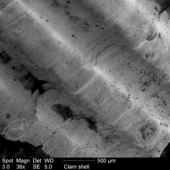
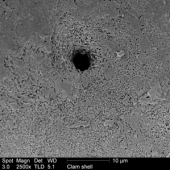
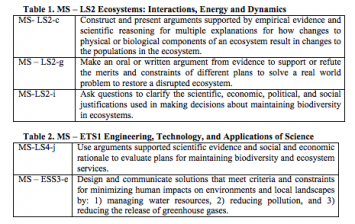



 Richard Hugo (hugo@pdx.edu) is an Assistant Research Professor in Geology at Portland State University. He has 12 years of experience leading student-centered field science investigations for students and teachers in underserved K-12 schools. He is also an electron microscopist who uses electron beam imaging and analysis to study geological and geomicrobiological processes.
Richard Hugo (hugo@pdx.edu) is an Assistant Research Professor in Geology at Portland State University. He has 12 years of experience leading student-centered field science investigations for students and teachers in underserved K-12 schools. He is also an electron microscopist who uses electron beam imaging and analysis to study geological and geomicrobiological processes.  Sean McAllister, born and raised in Alaska, earned his MS degree from Western Washington University in the field of marine microbial ecology. In addition to his active participation in science education, Sean is currently working on his PhD in Marine Biosciences at the University of Delaware, focusing on iron-dominated microbial communities on the sea floor.
Sean McAllister, born and raised in Alaska, earned his MS degree from Western Washington University in the field of marine microbial ecology. In addition to his active participation in science education, Sean is currently working on his PhD in Marine Biosciences at the University of Delaware, focusing on iron-dominated microbial communities on the sea floor. 
